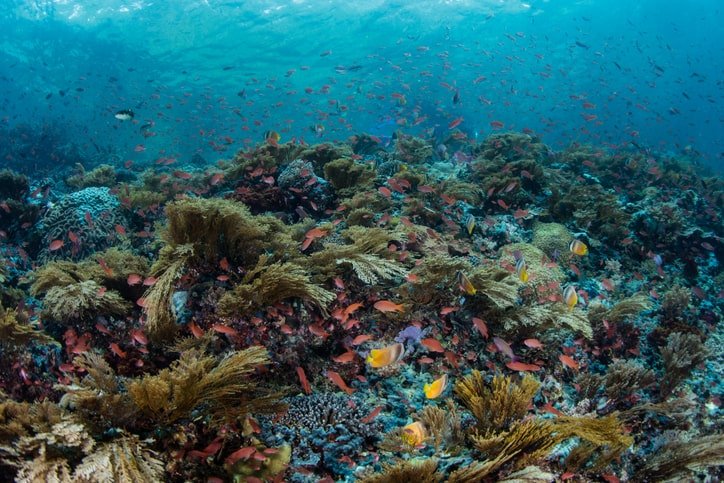Diving in Alor
Find out about the scuba diving in Alor, the array of wildlife in the surrounding ocean and the wide range of dive sites you can reach while staying at Alor Tanapi.

Scuba Diving in Alor
Located in the heart of the coral triangle, diving in Alor offers some of the best scuba diving experiences in Indonesia. It is renowned for its great visibility, stunning coral reefs, pelagic encounters, and small bizarre critters in the muck sites. From the resort, we can reach more than 40 dive sites within a 30 to 45-minute radius by boat.
It is also possible to do day trips to some dive sites located in the South of Alor or the South of Pantar such as Beang Abang which offers some great muck diving. We recommend a minimum stay of one to two weeks to be able to cover the range of dive sites.
Our Favourite Dive Sites

What attracted us to Alor is the diversity of dive sites available within a small range. Large pelagics such as mola sunfish, whales, dolphins, hammerhead sharks, and thresher sharks can sometimes be seen in the Pantar Strait. In addition to the beautiful coral walls and caves, Kalabahi bay’s black sandy bottom offers some great muck diving. Two species of rhinopias are found in Alor, as well as a wide range of critters including blue-ringed octopus, wonderpus, harlequin shrimp and ghost pipefish just to name a few. Some iconic sites in Alor include “Bama Wall” which is a beautiful steep drop off covered in corals and home to many resident colourful reef fish, “Mucky Mosque” for the macro lovers, and “Current Alley” for some pelagic encounters.
Visibility ranges from 15 metres/50 feet during and around the rainy season; to up to an impressive 40 metres/130 feet in the dry season (June to October), although in recent years this has been known to vary due to changes in weather patterns. The topography of the dive sites consists mainly of walls and slopes. The dive sites are located within a marine park where only local fishermen are allowed to fish.
Here are some of our favourite dive sites:
1. Crucifixion
Crucifixion, known locally as Kelalaka, starts with a steep colourful reef slope with impressive overhangs underneath it, then turns into a vertical wall. There are also two small pinnacles at 30-40 meters where more fish action can be observed.
2. Bama Wall
Bama Wall, sometimes called “The Great Wall of Pantar” is a steep drop off on Pantar island opposite of Alor. Here you will find a wall covered in healthy and colourful coral then a slope with many anthias, butterfly fish as well as fish feeding, fish hiding and sometimes schooling humphead parrotfish, snapper, Napoleon wrasse, trevally and many more.
3. Wolang Cavern
This cave is a highlight of Alor with two caverns inhabited by an array of creatures. You will usually find crabs, nudibranchs and sometimes large marble rays and nurse sharks where you can even see their eggs. Upon exiting the cavern, you will see a beautiful colourful wall full of orange soft corals.
4. Cathedral
This dive site is located in the South of Alor, and therefore, given the cooler temperatures of the South, we recommend wearing a 5mm wetsuit during this dive as it can get pretty cold depending on the thermoclines. The highlights of this dive site are its pristine and dense coral coverage, and a swim-through at around thirty meters.
5. Andy’s bus stop
Another stunning wall in the South of Alor, we are in awe of the coral coverage and anthias making it difficult to observe the amazing colours of the reef. Although you might be mesmerized by these incredible colours, do not forget to look out into the blue for some big fish action: hunting giant trevallies, tuna and napoleon are sometimes spotted here.
6. Yellow Corner
This dive site, sometimes also called Current Alley, is reserved for advanced divers, because as the name suggests, it is a dive site where the current can be strong for the best chances of spotting pelagics. During certain times of the year and depending on the moon phase as well as other conditions such as water temperature, it is possible to see hammerhead sharks. At other times, you will usually see barracudas, blacktip sharks, trevally, and large napoleons. If you are lucky you might also spot eagle rays.
7. Pool Party
This dive site is located on Pura island and it gets its name because of the many different types of schooling fish that can be seen here: fusiliers, sweetlips, snapper, batfish, great barracuda, turtle, wrasse, whip coral shrimp, anemone shrimps, lobster, and frogfish. Although the marine life is distracting, don’t forget to look at the beautiful coral underneath it as it is equally as beautiful and interesting.
8. Biatabang
A great place for a check dive after a long trip, Biatabang or “The Hanging Gardens of Babylon” site gives foreign divers an introduction to Alorese culture both above and below the water. Alorese fishermen typically prepare their traditional fish traps which they call “bubu” from bamboo weave. These fish traps are placed on the reef between corals with some rocks. Here you will have the opportunity to see the local fishermen free diving without any fins or equipment, only using their very own homemade goggles from glass.
9. Mucky Mosque
For divers who love muck diving or for those who would like to give it a try, Mucky Mosque in Alor offers some of the best muck diving in the world. Here you will find the weird and wonderful critters that are typically found in Lembeh, Ambon and Bali. You can usually see here frogfish, ghost pipefish, the harlequin shrimp and some amazing cephalopods such as the wunderpus, and if you are lucky enough to spot the most photogenic fish: the rhinopias.
10. Beang Abang
A must for macro lovers and underwater photographers, Beang Abang is a sandy bay on the Southern part of Pantar island with hot springs from the volcano pouring into the beach. The diving here offers the possibility to spot critters living in the black sand such as ribbon eels, ghost pipefish, octopus, nudibranchs and hairy frogfish.





Diving Details
Temperatures
The average temperatures around Alor are lower than the average found in Indonesia. Although the average is between 26°C to 28°C (78-82°F), thermoclines are common and the water can drop at times to 20°C (68°F), sometimes 16°C (60.8°F).

Wetsuits
We recommend a minimum of a 5 mm long wetsuit when scuba diving in Alor, as well as gloves and a hood. If you get cold easily, we recommend a 7 mm long wetsuit.

Moon Phase
We recommend planning your stay accordingly to align with the lunar cycles, ensuring optimal conditions for your dives. If you’re adventurous, like currents, and eager to encounter larger marine life, booking around the new moon and full moon can provide exhilarating encounters. Alternatively, for those seeking calmer dives, we advise avoiding these peak lunar periods.
Experience
The Pantar Strait is renowned for its unpredictable currents, therefore we recommend having at least 100 dives and feeling comfortable with drift diving if you would like to be able to fully enjoy the range of dive sites that Alor has to offer.
Please note: As we are located in an area with strong currents, we are not able to offer any house reef diving.
Also, we ask that guests sign an “Environmental Awareness” statement on arrival pledging kindness and respect to the reef and the local environment. A copy of this statement can be read here.

Alor Diving FAQs
What kind of diving can we expect to find in Alor?
Diving in Alor offers a nice balance between pristine, colorful coral reefs where schools of fish can be encountered, and muck dive sites where the unique critters are usually spotted. The coral sites are mostly bottomless walls or feature a sloping topography where current can vary from mild to strong with good visibility, while in the muck sites you will find a sandy black bottom with little current and average visibility.
What is the water temperature in Alor?
The average temperature is usually between 24-30°C, but it has been known to drop in certain areas to 20°C, in some Alor dive sites you might feel a thermocline of 16°C. We therefore recommend a 5mm wetsuit, gloves and a hood if you get chilly.
What diver certification level is required?
To be able to go fun diving, a minimum certification equivalent to PADI Open Water is necessary. We also recommend having at least 50-100 dives in order to be able to enjoy and feel comfortable in the Alor-Pantar waters.
Can I take a dive course?
Please contact us if you would like to take a diving course during your stay in Alor.
How many dives do we do per day?
We generally offer 3 dives per day due to our remote location, we prefer not to push the limits. In exceptional cases we might offer the possibility of doing a 4th dive for a group, but this is to be discussed prior to the booking.
Are there any limitations on the diving?
Alor scuba diving is usually between 15-25 meters and ask that all divers stay within the limits of their qualifying certifications. All dives are required to be no-decompression dives, we do not allow solo-diving and we reserve the right to cancel any unused dives should divers not respect and follow the rules of the company.
Do I need evacuation and diving insurance?
Yes, DAN (Diver’s Alert Network) insurance or equivalent is mandatory for scuba divers due to our remote location.
Are there first-aid facilities?
We have a first-aid kit at the resort and on the boat.
What dive equipment do I need?
Tanks, weights and weight belts are included in the dive prices. If you need other equipment such as wetsuit, BCD, regulator, mask, fins, snorkel, dive light, dive computer, etc. please see our rental price list.
Is there dive equipment for rent?
We have limited dive equipment for rent so we kindly ask that you contact us beforehand if you will need to rent equipment. We have Aqualung BCDs and regulators, Mares 5 mm wetsuits and fins. We strongly recommend purchasing your own wetsuits and masks for maximum comfort.
Do you use INT or DIN valves?
Our tanks can be converted from DIN to INT.
What facilities are available for photographers and videographers?
We have a dedicated camera room at the dive center for photographers and videographers, there is also ample room in the bungalows for keeping equipment, and we have a TV screen in the main restaurant-lounge area to view photos and videos in the evenings. We also provide camera only rinse buckets.
Can I fish or spear fish?
We will be diving in a marine park reserved for local fishermen only, therefore we cannot fish or spear fish.
Am I allowed to wear gloves?
There is no rule against wearing gloves but we will not allow guests to touch the reef unless for safety reasons. We ask that our guests sign an “Environmental Awareness Statement” on arrival that says they will be responsible divers and respect the marine life, we reserve the right to cancel any unused dives in the event that guests do not follow and respect these rules. If you need to stabilize yourself while shooting photos, we recommend using a pointer with a soft tip (plastic or similar). Buoyancy control is of utmost importance and we’ll be happy to give you advice and help you improve your diving skills at no extra charge if we see there is room for improvement. The ability to drift dive and feel comfortable in strong currents is also required due to the challenging conditions in the Pantar Strait. Please refer to our sustainability page for more information on environmental responsibility.
Diving insurance is mandatory due to our isolated location, the nearest hyperbaric chamber is located in Bali and evacuation costs and chamber expenses are not covered under standard medical insurance. We recommend DAN insurance, you will need to purchase according to your country of residence.

Check Out Our Alor Dive Center & Courses



